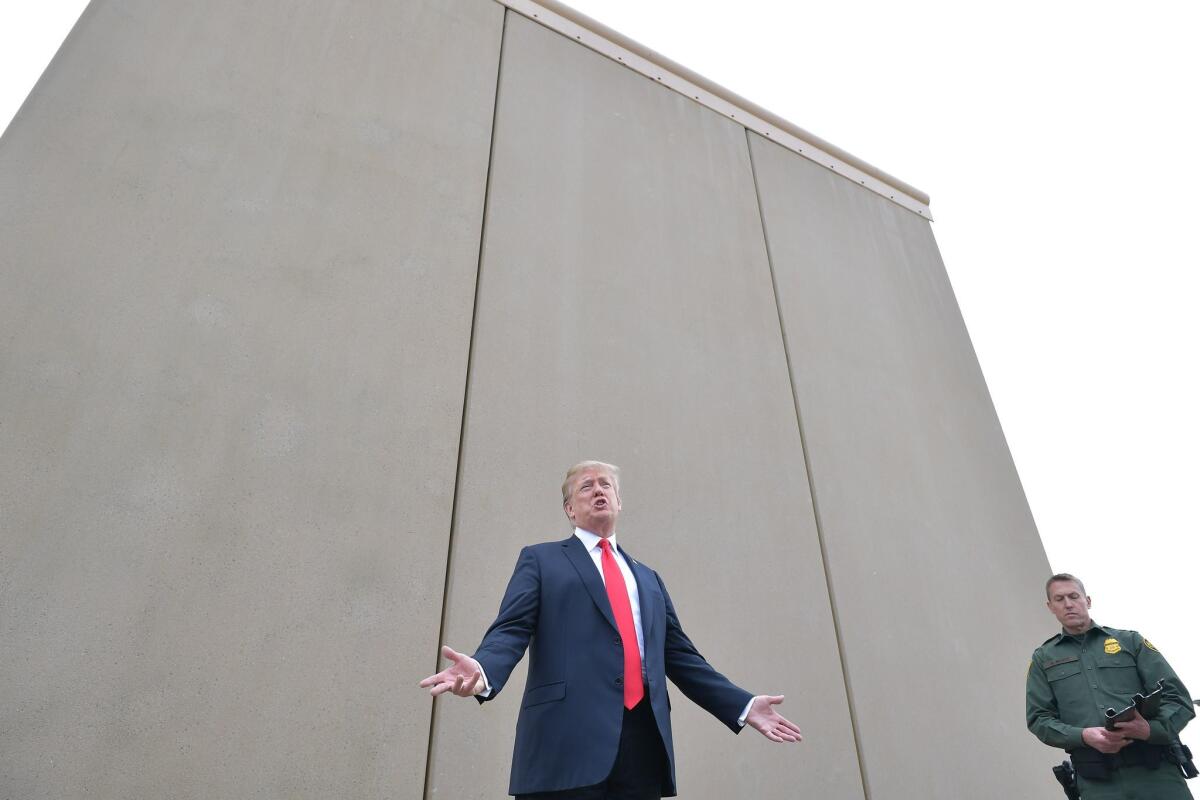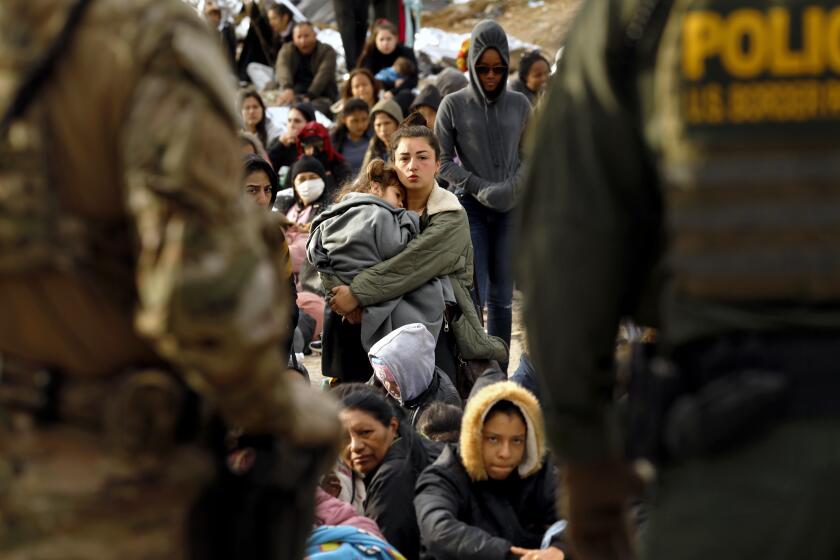Trump’s immigration changes will affect California long after he’s gone

It was a Monday morning in Washington three weeks from the November presidential election and on the first day of Senate hearings for his Supreme Court pick, with more than 210,000 Americans having died from COVID-19, President Trump tweeted:
“California is going to hell. Vote Trump!”
For nearly four years, California has been among Trump’s favorite punching bags, in large part due to clashes over his central 2016 campaign promise: To restrict immigration.
It’s a pledge he’s made good on in ways that will be felt in the state long after his tenure ends.
Trump’s more than 400 executive actions to restrict immigration have had an outsize impact on the Golden State.
He has targeted the Silicon-Valley based tech industry by squeezing high-skilled foreign labor, and has restricted immigration based on family reunification even as he’s separated thousands of migrant families at the border.
He has attempted to repeal federal protections for young immigrants who entered the country illegally as children and sidestepped the Supreme Court’s rejection of his plans. California has more residents covered by those protections, known as Deferred Action for Childhood Arrivals, or DACA, than any other state. He has also ended Temporary Protected Status for refugees from El Salvador and other Central American countries, a disproportionate number of whom live in the state.
And his administration has discouraged thousands of other students, refugees, asylum seekers, workers, and entrepreneurs — many headed to California — from coming to the United States at all, most recently by using the COVID-19 pandemic as a justification for largely shutting the nation’s borders.
Former Vice President Joe Biden has pledged to reverse course if he defeats Trump in this year’s election. But Biden has taken specific stands on only some immigration issues while pledging to work with Congress to find unspecified solutions to others that, in some cases, have defied legislative compromise for decades.
Even if a Biden administration does find such solutions, he would inherit an immigration system that has been battered during Trump’s tenure and faces a ballooning backlog of cases. And some of the impacts of Trump’s policies would be difficult to erase.
The most tangible may be the fear and uncertainty Trump’s rhetoric and raids have created in immigrant communities in California, leaving many in years-long limbo and limiting opportunities.
Even under President Obama, people were skeptical of local police involvement in immigration enforcement, but Trump has “greatly magnified” the concerns, said Hiroshi Motomura, an immigration law professor at UCLA School of Law.
“To really separate out local law enforcement from immigration — that’s a major thing that will survive past Trump,” he said.
Biden plans to use California as a template for a frenzy of advancements in clean energy and environmental justice. The state would reap big benefits.
California has taken the lead in opposition to many of Trump’s immigration policies, notably its attempts to do away with DACA. The University of California was a lead plaintiff in the case that went to the Supreme Court. The system’s president, Janet Napolitano, crafted the DACA policy as Obama’s Homeland Security secretary.
State Atty. Gen. Xavier Becerra, the son of Mexican immigrants and the first Latino to serve as the state’s top lawyer, says he’s sued the Trump administration more than 100 times, often over immigration issues.
“I never expected to have to sue the president,” Becerra said. “We don’t sue Donald Trump because it’s easy or fun ... If he wouldn’t break the law, we wouldn’t take him to court.”
Biden has pledged he would work with Congress for a permanent legislative replacement for DACA, as well as a path to citizenship for the estimated 10.5 million undocumented immigrants in the U.S. He also says he would change American foreign policy toward Mexico and Central America, with more emphasis on diplomacy and less on enforcement. And Biden said he would end the use of for-profit detention centers to hold migrants, which have proliferated under Trump.
Biden has not endorsed the calls from some progressives for dissolving the Homeland Security department and ICE, in particular, saying, instead, that he’d increase training and oversight.
The Democratic candidate says he would tackle the backlog of immigration cases by increasing the number of immigration judges, court staff, and interpreters. But with promises to end policies such as “Remain in Mexico,” he’d have to confront the claims of tens of thousands of asylum seekers stuck south of the border under Trump, as well as those who have already been waiting years to have their claims heard.
For state officials, the biggest impact of a change of administrations might be no longer being the constant foil for Trump’s political attacks.
Trump has been railing against California’s cities and their immigration policies since his first presidential campaign. Last year, he threatened to dump detained migrants into “sanctuary cities and states,” despite his own advisors telling him that such an action would be illegal.
“California certainly is always saying, ‘Oh, we want more people,’” Trump said. “And they want more people in their sanctuary cities. Well, we’ll give them more people. ... Let’s see if they’re so happy.”
Earlier this month, Chad Wolf, Trump’s acting Homeland Security secretary, and Tony Pham, the interim Immigration and Customs Enforcement director, held an unusual news conference in Washington about ICE enforcement actions in San Diego, Los Angeles, and San Francisco — chosen, the officials said, because they are so-called “sanctuary cities.”
“Sanctuary” jurisdictions in California — like others across the country — have vowed to protect people who are in the country illegally. On a statewide basis, California provides some benefits for people without legal status, including healthcare and driver’s licenses. And a law signed by former Gov. Jerry Brown limited cooperation between local law enforcement agencies and federal immigration agents.
ICE’s latest enforcement actions, dubbed “Operation Rise,” resulted in the arrest of 128 immigrants, Wolf and Pham said, a relatively small number for an agency that averaged nearly 400 arrests a day last year.
Wolf insisted the timing of his news conference had no tie to the election.
“Nearly four years ago this administration put forth an ‘America-first’ strategy with a clear mandate to secure our borders,” he said. “Unfortunately, certain local political leaders, including many in California, continue to put politics over public safety.”
He told California residents to “continue to expect a more visible ICE presence.”
It is all here. How to vote. Where to vote. Endorsements. What issues are on the ballot in California and Los Angeles County.
Tom Wong, an associate professor of political science at University of California, San Diego, and a former Obama White House immigration advisor, called such statements an example of the administration’s political “theater” on immigration.
Using federal data, Wong’s research found less crime in so-called sanctuary localities relative to comparable areas.
“The facts do not support the administration theater when it comes to this image of sanctuary localities as being lawless and rampant,” said Wong.
Beyond the rhetorical broadsides, the administration has taken several steps that have been acutely felt by immigrant communities.
One of Trump’s early executive orders made every immigrant in the country illegally a priority for arrest, in contrast with Obama’s use of prosecutorial discretion to prioritize those with criminal records.
More recently, invoking the pandemic, Trump officials have sought to speed up removals of immigrants who cannot prove they have been in the country continuously for two years, without a hearing before a judge.
Overall, however, immigration arrests and removals by ICE have fallen under Trump — though the proportion of those deported without criminal records has more than doubled, according to the Migration Policy Institute.
As COVID-19 led to widespread job loss and deaths, disproportionately borne by Latinos and Blacks and hitting the agriculture, food-processing, and health-care sectors in California particularly hard, the administration insisted that Congress make millions of immigrants without legal status — as well as many of the 1.2 million Americans who filed taxes jointly with a non-citizen spouse — ineligible for federal stimulus checks.
Rep. Zoe Lofgren (D-San Jose) said Trump ignores that immigrant workers in the California economy play a key role nationally.
“California has the most productive farming in the U.S., and more than half of the farmworkers are undocumented,” Lofgren noted. “If they weren’t there, our agriculture sector would collapse.”
That exclusion tracks with other “wealth test” policies the administration has put into place to keep low-income immigrants out of the country or to deny them citizenship. Under Trump, the government has adopted what’s known as a “public charge” rule, which would deny permanent legal status to immigration who might use, or whose U.S. citizen children might use, public benefits.
While these policies have been tied up in litigation, they have already had a chilling effect, discouraging thousands from accessing benefits in California and other states.
The Trump administration has also sought to restrict citizenship in other ways, raising fees and slowing processing of hundreds of thousands of potential 2020 voters waiting to be naturalized — most of them in California, according to a report by Boundless Immigration.
All of those policies have taken aim at California constituencies, said Lofgren.
“If you don’t love him, he tries to destroy you,” she said. “But it’s impossible to destroy the biggest state without harming the rest of the country tremendously.”
More to Read
Get the L.A. Times Politics newsletter
Deeply reported insights into legislation, politics and policy from Sacramento, Washington and beyond. In your inbox three times per week.
You may occasionally receive promotional content from the Los Angeles Times.









